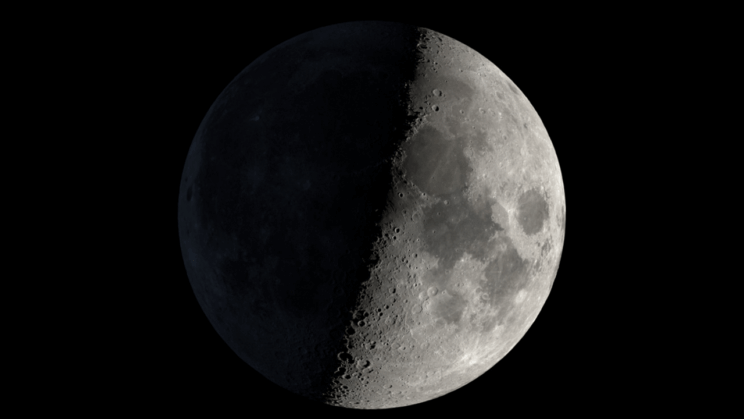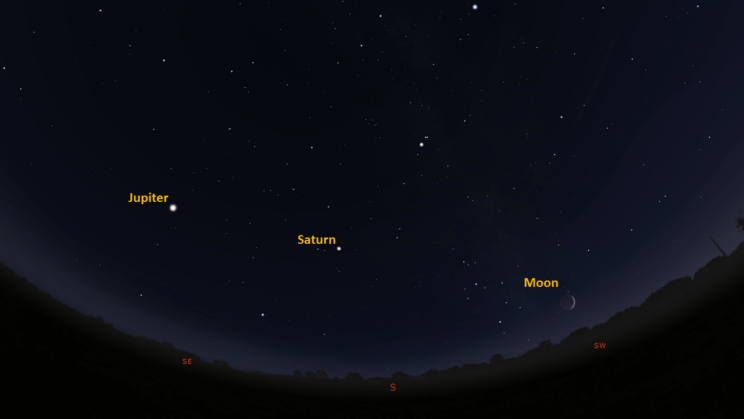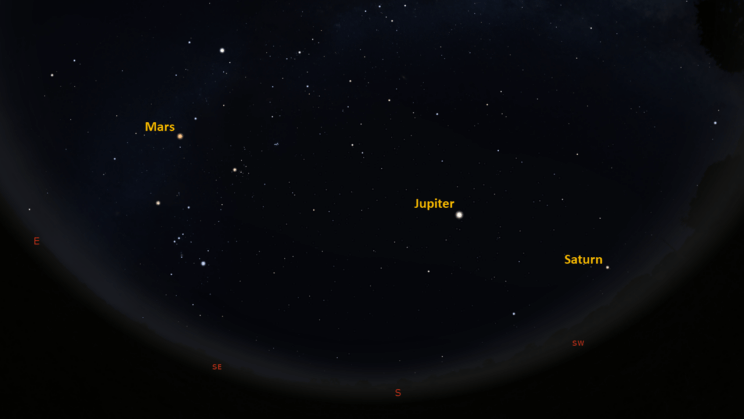This is the Saint Louis Science Center’s NIGHT SKY UPDATE for the week of Friday, October 28, 2022.
Information updated weekly or as needed.
Times given as local St. Louis time which is Central Daylight Time (CDT). For definitions of terminology used in the night sky update, click the highlighted text. If relying on times posted in Universal Time (UT), St. louis is -5 hours when CDT.
Public Telescope Viewings
Public telescope viewings at the McDonnell Planetarium have returned as part of the Saint Louis Science Center’s First Friday event. As we ease back into our telescope nights, they will operate a little different than before. To take part in our telescope viewings you will need to get a ticket for the planetarium show that starts at 7:00 p.m. as part of the First Friday event. Tickets for the First Friday planetarium show are free, but they can only be picked up at the Saint Louis Science Center on the night of the event. After the planetarium show ends you will be able to go outside and look through telescopes weather permitting. We will update this posting if anything changes.
Observing Highlight of the Week

First quarter moon occurs on November 1, 2022. Image credit: NASA, SVS, Ernie Wright.
This week we will cover the anniversary of a great science fiction production, the Moon and a couple of active meteor showers.
To start things off, the Moon is in its waxing half of its synodic cycle. The Moon will exhibit a waxing crescent through waxing gibbous phase from October 28 through November 5. During this period, the Moon will pass near the planets, Saturn, Neptune and then Jupiter as it wanders through the constellations Ophiuchus, Sagittarius, Capricornus, Aquarius, Pisces and Cetus. On November 1, 2022, the Moon reaches its first quarter phase. On this day, you will find the Moon due south as the Sun sets for the day. This also means we are just a week away for the next total lunar eclipse visible from St. Louis. This eclipse occurs on November 8, 2022. We will be able to see all of totality, but the Moon sets before the eclipse ends. What we can see in St. Louis starts at 2:02 a.m. and ends as the Moon sets at 6:44 a.m.
The two active meteor showers worth noting this week are the Southern and Northern Taurids. Both showers find their radiant in the constellation Taurus and are both caused by the comet 2P/Encke. Both are considered minor meteor showers producing roughly 5 meteors per hour when at peak activity. However, both meteor showers produce an increase in activity on a period of roughly 7 years, which last occurred in 2015. The increase is not huge being about double the normal peak rate. What makes this potential swarm notable is it often shows an increase in fireball activity. Fireballs are larger than average meteors that become brighter than any planet or star. The peak for the Taurids is not a sharp peak, but rather increased activity occurs for about two weeks centered on the peak date. This year the Southern Taurids peak on November 4-5, 2022, and the Northern Taurids peak on November 11-12, 2022. The best views for both meteor showers come after midnight as their radiant is seen higher in the sky.
Lastly, October 30 marks the anniversary of the Orson Wells radio production of H.G Wells War of the Worlds. This was a Halloween episode of the radio series The Mercury Theatre on the Air, that famously when aired in 1938, convinced some listeners that Earth was under attack from Martians. If you have not listened to the production before, it is worth checking out as a bit of early Halloween entertainment.
Conveniently, Mars will easily be seen on October 30, 2022, by 11:00 p.m. in the constellation Taurus. If you have a telescope at home, this is a great opportunity to check out what inspired many people’s thoughts that Mars may have supported life. A thought that would later be disproven as probes sent to Mars revealed a desolate surface incapable of currently supporting life. The surface of Mars is already visible though most backyard instruments to grab a copy of the famous radio production and peek at the Martian surface while you listen.
The Sun and Moon

The Moon as seen from the International Space Station, on July 31, 2011.
Credit: NASA
Sunrise is at 7:23 a.m. on Friday, October 28 and sunset is at 6:05 p.m. providing us with roughly 10.5 hours of daylight. Even after sunset, the light from the Sun will dimly illuminate our sky for roughly 1 hour and 30 minutes. This period is called twilight, which ends around 7:35 p.m. this week. For those with a sundial, local noon occurs around 12:44 p.m. this week.
| Day | Sunrise | Sunset |
|---|---|---|
| 2022-10-28 | 7:23 a.m. | 6:05 p.m. |
| 2022-10-29 | 7:24 a.m. | 6:04 p.m. |
| 2022-10-30 | 7:25 a.m. | 6:03 p.m. |
| 2022-10-31 | 7:26 a.m. | 6:02 p.m. |
| 2022-11-01 | 7:27 a.m. | 6:00 p.m. |
| 2022-11-02 | 7:29 a.m. | 5:59 p.m. |
| 2022-11-03 | 7:30 a.m. | 5:58 p.m. |
| 2022-11-04 | 7:31 a.m. | 5:57 p.m. |
| 2022-11-05 | 7:32 a.m. | 5:56 p.m. |
Moon
Moonrise for Friday, October 28 is at 11:09 a.m. and moonset occurs at 8:25 p.m. Friday, October 28, the Moon will exhibit a waxing crescent phase with 14% of the lunar disk illuminated. First quarter moon occurs on November 1, 2022, at 1:37 a.m.
International Space Station (ISS) Observing

Visible passes of ISS from St. Louis for the week of October 28 occur during morning hours. The best passes this week occur on the mornings of November 4 and 5. Use the table below for information about these and other visible passes this week.
Catch ISS from St. Louis starting Friday, October 28
| Date | Starts | Max. altitude | Ends | |||||||
|---|---|---|---|---|---|---|---|---|---|---|
| Time | Alt. | Az. | Time | Alt. | Az. | Time | Alt. | Az. | ||
| 02 Nov | -1.5 | 06:49:30 | 10 | NNW | 06:51:51 | 18 | NNE | 06:54:12 | 10 | ENE |
| 03 Nov | -1.2 | 06:00:04 | 11 | N | 06:01:19 | 13 | NNE | 06:03:01 | 10 | NE |
| 04 Nov | -2.5 | 06:50:53 | 10 | NW | 06:54:01 | 36 | NNE | 06:57:07 | 10 | E |
| 05 Nov | -1.8 | 06:02:51 | 18 | N | 06:04:15 | 23 | NNE | 06:07:01 | 10 | E |
Magnitude (Mag): The Measure of brightness for a celestial object. The lower the value is, the brighter the object will be.
Altitude (Alt): The angle of a celestial object measured upwards from the observer’s horizon.
Azimuth (Az): The direction of a celestial object, measured clockwise from an observer’s location with north being 0°, east being 90°, south being 180° and west being 270°.
For information about ISS flyovers and other visible satellites, visit www.heavens-above.com
Detailed information regarding all unmanned exploration of our universe, missions past, present, and planned, can be found at Jet Propulsion Laboratories:
The Visible Planets

Looking south at 7:00 p.m. on October 28, 2022. Credit: Stellarium, EG

Looking south at 12:00 a.m. on October 29, 2022. Credit: Stellarium, EG.
This week, three naked eye planets are visible. Mars rises before midnight but will still be best seen in late evening and morning hours. Jupiter and Saturn are now evening targets visible not long after sunset.
Mars
Mars rises at 8:49 p.m. Start looking for the red planet around 10:00 p.m. as it clears trees and buildings. Mars is headed towards opposition later this year on December 7, 2022.
Jupiter
Now past opposition, Jupiter will be visible about 30 minutes after sunset. Jupiter reaches superior conjunction on April 11, 2023. As we progress towards this date, we will see Jupiter slowly wander towards the Sun.
Saturn
Now past opposition, Saturn rises before the Sun sets. You can find this giant world in the south about 45 minutes after sunset. Saturn is still a fine target though telescopes and will be a highlight of the evening sky for the rest of the year.
James S. McDonnell Planetarium
Night Sky Update: October 28 – November 5, 2022






